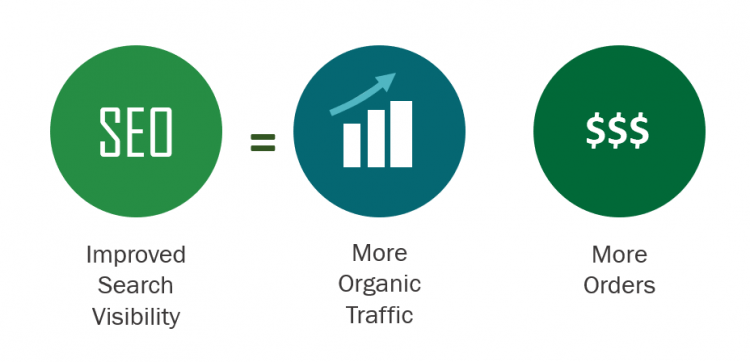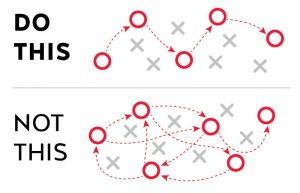If you are responsible for evangelizing SEO within your organization and educating colleagues on why organic search matters, this post is meant for you.
It’s challenging to stay on top of the constant changes in the world of organic search. It can be equally challenging to explain SEO up, down and across the ladder so everyone understands its importance to your business. You have to be competent in your knowledge of SEO, but equally important to your career is ensuring those around you understand how organic search works and why it requires attention and investment.
Where to Begin
A recommended starting point is using data to stress the overall importance of organic search for your company. There are numerous research reports out there, but a compelling statistic from BrightEdge is that on average, 51% of all traffic is coming from organic search, which confirms that it is still the largest channel driving web traffic. And better organic search visibility leads to more traffic, which can ultimately lead to more orders and more revenue.

There are over 200 ranking factors that Google uses in its algorithms, so it’s impossible to state what may be the exact cause of a ranking or traffic increase or decrease when you’re asked to explain inside your organization. And while you have insight into changes that have been made with your site, it’s not as easy to share what may be causing a competitor’s site to go up or down. If you mentioned more than 5 or 6 of these potential ranking factors to non-SEO colleagues, their eyes would probably glaze over. It’s important to boil down to the basics.
As the most basic level, your colleagues need to understand that Google wants to create the best user experience for searchers and ensure Google is answering their questions satisfactorily. That will keep bringing people back to Google. So, your company’s job is to make the best possible site in your market space for users, as this ultimately will make it more attractive to Google to show your site higher in the search results.
There are four basic components you can explain that will help your company in organic search.
Content

The first component is content. If your company focuses on addressing the questions on the minds of your customers, you’ll have a leg up.
Hopefully everyone in your company is focused on your customers, so that’s a good place to start. Paint a picture of how potential and current customers could utilize your site. Google’s Micro-Moments model of searchers wanting to “know, go, do, or buy” is one that is easily understood.
Describe how your site could be used in each of those four instances and think about what questions you can answer for your customer in each phase. Your company needs to create useful, aligned, and unique content that addresses those questions. You may need to stress the investment it takes (time or dollars) to create meaningful content – and content that outperforms the competition.
User Experience

Another part of the equation is a positive user experience. It’s one thing to have incredible content, but it needs to be easily found by your visitor or they won’t come back to your site. Navigation, page loading time, and a strong internal linking structure among pages play a part.
To help drive home the importance of user experience, you can ask colleagues to spend a few minutes completing a task, like finding a specific product or looking to answer a question both on your site and some of your competitors’ sites. Which experience is better?
Another good exercise is to have them interact with your site on their mobile phone – and explain what % of traffic is coming to your site from mobile.
Technical SEO

The third component of organic search, the technical side, is probably the hardest to explain to non-SEO colleagues because it’s not something that can be easily seen like content or user experience. You need to explain that even though they can’t see what’s going on behind the page, Google certainly can, so you need to keep your site in good working shape.
Title tags, meta descriptions, alt attributes on images and URL names are all important. So is the overall navigation structure of your site and the coding practices used to develop it. Take a minute to show them the code behind a page to help drive the point home. A well-thought-through site hierarchy is key – this can be demonstrated with the aid of your site map. Explain how an audit can help uncover all of these technical elements.
Outside Signals

The fourth area is one your colleagues may understand better, especially if they’re in marketing. The world at large sends signals to Google about the strength of your site versus others in your space. If you have more branded searches than your competitors, which could be a result of solid marketing and exceptional customer experience, Google will likely take note and may rank you in a higher spot vs. your competitors.
The same can be said for online customer reviews and ratings, both from a quality and quantity standpoint. Additionally, having more backlinks from credible and relevant sites can be explained as “votes” that Google takes into consideration as another ranking factor. Show your counterparts how your branded search query volume, ratings and reviews, and backlink profile compares to your competitors. If you’re behind your competition, explain why you need to catch up and how you can do so. If you’re ahead, you need to stress the importance of staying on top.
Final Thoughts
It’s important to convey that it takes time for investments in organic SEO to pay off – it’s not going to have as immediate an impact as running a paid search or email campaign. But if you build a foundation for strong content, user experience, technical SEO, and outside signals, then the results will pay off over time. The oft-used analogy of a marathon vs. a sprint is true.
Finally, you can employ another strategy for getting others to understand organic search. There is a reason companies use case studies and examples when selling something – they work. Look for relevant examples to share of businesses that have improved their organic search when you’re trying to explain internally how SEO can help your business. If you work with outside partners, like an agency or analytics provider, ask them for help. They often can share case studies or research that can support your efforts. Or they may be able to host workshops or training sessions to help educate your internal teams.
Make sure you’re continually repeating these core tenets of organic search in meetings or written plans. It takes time to learn something new, and the more you educate and share, the greater the chance your points will take hold internally, making your job easier.


I still need to build a full site to replace my current one, but I am glad I am reading all these articles before hand. The sitemap especially is something I should think out ahead to keep it as user friendly as possible.
You need your clients to understand what you are doing to get the best buy in.